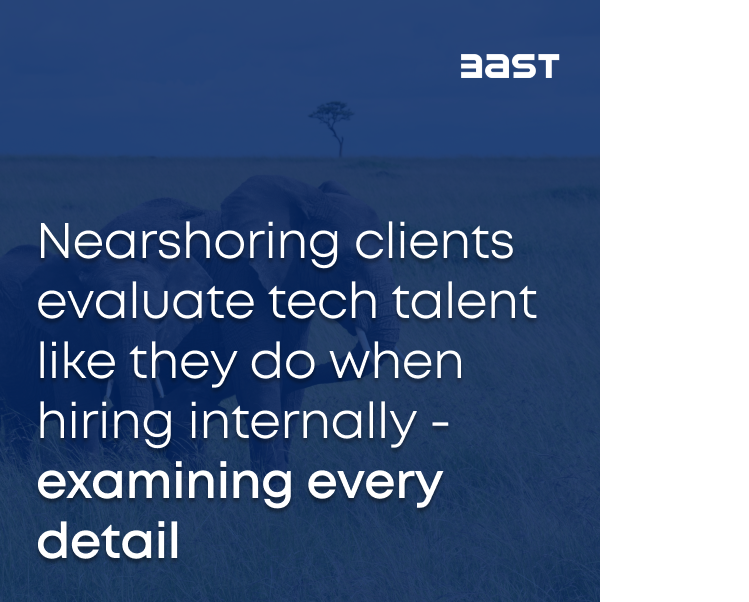Do you know what puts clients off experienced and skilled job candidates in the process of IT outsourcing?
Their CV.
Yes, ironically the document that’s supposed to pick interest in a professional often stops the hiring process in its very beginning. And we can tell you why, because we have quite the experience with bad resumes of talents in the IT industry. What’s more important, we can tell you how to avoid such an unwanted turn of events.
But first, let’s underline that we are not skeptical about the IT talent quality in Eastern Europe. On the contrary, we fully trust that behind the profiles you are sharing with us sits a quality professional.
 In the Nordics, insourcing is very much in fashion in the IT industry at the moment, so clients are often looking for team augmentation and they evaluate tech talent in a similar fashion they do when hiring internally. Which means they examine every detail of the candidate’s resume when it comes to expanding through nearshoring. And they often do this before engaging in further talks with the candidate or vendor.
In the Nordics, insourcing is very much in fashion in the IT industry at the moment, so clients are often looking for team augmentation and they evaluate tech talent in a similar fashion they do when hiring internally. Which means they examine every detail of the candidate’s resume when it comes to expanding through nearshoring. And they often do this before engaging in further talks with the candidate or vendor.
And thus it becomes quite simple. If the CV is not well-structured and it is lacking information, clients are much less likely to move forward with the candidate. This means that you need to make sure that your talent’s technical know-how, capabilities, prior project experience, and strengths are clearly outlined in it since quite often, clients’ first impressions are based solely on its content.
In this article, we will tell you how to do it by optimizing your processes. And the first step is to know a bit more about what hiring companies are looking for in a resume.
What clients look for in a tech talent’s CV
Often the starting point is quite blunt from a client’s perspective. They first look at:
- Seniority
- Technology stack
- Location
- Industry-specific experience from past projects
In addition to this information from the resume they also check the offer for:
- Availability
- Price
So it pays to know what they are searching for. Do they want to hire a seasoned pro who brings to the company a set of skills besides coding like helping in the overall architectural planning or in process development driven by business requirements? Or are they hoping to find a younger pro who also comes with a penchant for the new, tenancy to do also more menial tasks and a lower price tag?
You should make sure that the candidate is not selling themselves short by not listing all the tech they’ve used throughout their career. And of course, clients want to know if they can afford the talent and if their availability would fit the schedule. If the information they’ve found seems relevant, they look more closely at
- What is the specific experience with important technologies?
- What type of projects and client setups they are used to working on?
Some of the things can be quite hard to evaluate, so it’s not a specific sentence or a bullet point. It’s rather about the CV having enough information so one can read between the lines. You should practice a bit of foreseeing and be able to guess if the client will have questions like
- Would this candidate have the capability to lead more junior developers?
- Would this candidate have experience in defining architects for projects?
- Could this candidate work independently?
 But it’s more about logic, professionalism, and having the right partners than knowing how to use a crystal ball.
But it’s more about logic, professionalism, and having the right partners than knowing how to use a crystal ball.
What we don’t like, is to receive comments from our clients like:
“Seems like she would probably have the required expertise, but it was impossible to evaluate as there wasn’t really any information on the projects, so we didn’t move forward with this candidate.”
So here’s what you should do to avoid it and not spoil your chances of making a good sale.
What you can do to make a candidate more attractive
1. Do a quality assurance of the CV
We have prepared some general tips to improve the CV quality that we have gathered towards our first-hand impression of working with IT profiles on a daily basis.
Talent in the IT industry is often not the best at presenting their know-how and specific skills. So if you want to improve their hiring chances, especially when it comes to nearshoring, interviewing the candidate and making sure there is no information missing in the CV can be a good option.
Also here’s a short checklist before you send a resume for a client to review:
- Does the candidate have a summary, highlighting their overall experience?
- Does it have a chronologically ordered work experience, with a summary for each of the roles they were fulfilling?
- Does the candidate have relevant projects listed, with a summary of their involvement in the project and the technologies that were used?
- Does the candidate have their highlighted tech stack listed?
Let’s have a closer look at the first two.
You should ensure that the developer has summarized their experience. This part should highlight their experience and help them make a strong impression from the get-go. It should avoid buzzwords and focus on meaningful qualifications and skills.
When it comes to the way the CV should be structured, chronological order is the preferred format. HR specialists are used to it and this will make it easier for them to find their way through the information. Check if the candidate has included details about each of their roles – responsibilities, and achievements are key.
This checklist is key in constructing a good resume. And since the latter is an important process there will be a whole article dedicated to it, including major tips from East’s first-hand experience. It’s coming up really soon so stay tuned!
For now, let’s go to our next tip.
2. Use a centralized system to manage your candidate profiles in one place
In order to increase the chances of sales success you should structure your internal IT outsourcing processes better. It would help if you keep all the CVs in one place and keep track of candidates’ availability so you can quickly propose a suitable candidate for a new opportunity.
 And yet again we are here to help. We offer a great solution for managing talent CVs and finding new opportunities with low effort – ßeast! This is our tool which gives you various options to streamline your process and get more of your IT talent hired.
And yet again we are here to help. We offer a great solution for managing talent CVs and finding new opportunities with low effort – ßeast! This is our tool which gives you various options to streamline your process and get more of your IT talent hired.
In our partner portal, you can create consistent and professional-looking CVs by customizing a template to share your tech talent’s CVs with your clients (without being linked to East). You can also edit candidates’ availability and rate and propose them for East’s client requests. Furthermore, you receive opportunities from East that match candidates’ capabilities without having to do anything. Couch and remote control, here we come!
Also, you won’t lose any time in making sure that the candidate you are offering is in line with the client’s requirements for a specific position (tech stack, seniority, rate level, etc). In ßeast, we have a tool that automatically checks for must-have technologies when offering a candidate.
And now there’s just one thing left.
3. Prepare a comprehensive offer and avoid unnecessary emails
Make sure the negotiating process is smooth and rapid. Firstly, this means going through the CVs again to check if they are consistent. Also, see whether the candidates’ availability and all relevant information are listed. Plus, the offer should look clean and be comprehensive – all the details should be covered and the scope of the project is clear. This helps avoid unnecessary back-and-forth emails and makes it easier for the client to make a decision. And we all know that we need fewer emails in the IT industry.
Keep in mind that ßeast helps you with all of this. With our portal, you can send out a link to your offer where you can list all your candidates. And there is another advantage to using it – when we at East receive a request from our client, we first look for profiles from our ßeast IT talent database, in order to fulfill the requests. This means that if you use the tool you are more likely to make a sale.
Conclusion

The CV, the very document that is supposed to help an IT talent get hired, is often the main reason they don’t get the job. A poorly written or poorly processed resume stops clients from even considering a candidate.
That’s why if you want to be successful in the IT outsourcing industry you should work on your processes in order to ensure CVs work for and not against you. Focus on quality assurance, take advantage of our tool – ßeast, and make it as easy as possible for the client to say YES!
I’m an expert in communications, partner relations, processes, and operations with understanding of the Nordic mindset. I have developed an in-depth perspective on the successful offering process of IT services and talent presentation to the Nordic clients.
I currently aid Nordic companies to source talent from Eastern Europe and set up processes to improve the efficiency and success rate of IT offshoring and nearshoring ventures. I’ve gained my knowledge about Nordic cultures studying Scandinavian studies in Sofia university and living in Sweden.
Follow me and East on LinkedIn to stay updated about new articles.







